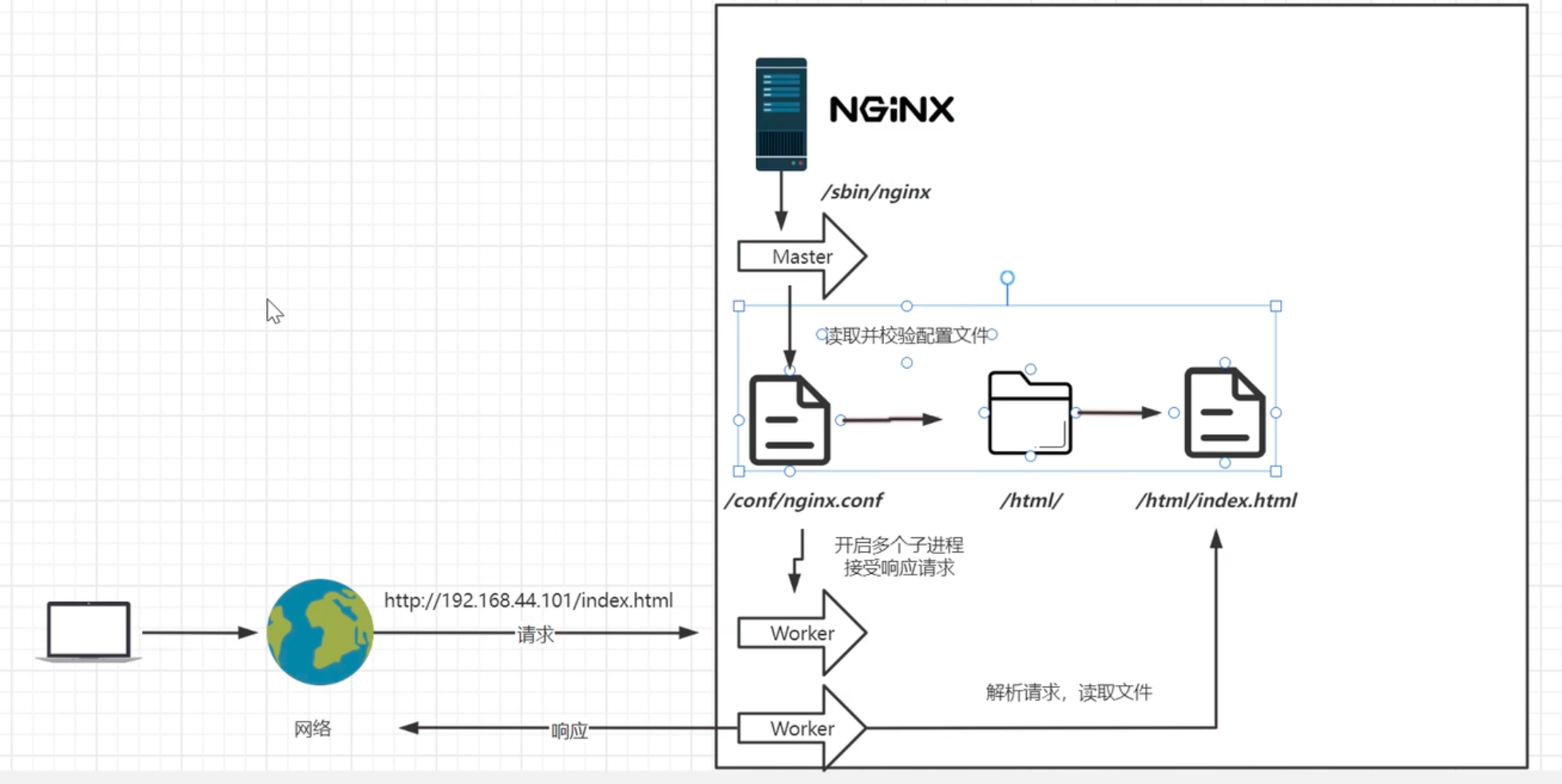Nginx Basic
Nginx Basic
Nginx starts with multiple processes
[root@node1 nginx]# ps -ef | grep nginx
root 25420 1 0 11:39 ? 00:00:00 nginx: master process /usr/sbin/nginx
nginx 25421 25420 0 11:39 ? 00:00:00 nginx: worker process
nginx 25422 25420 0 11:39 ? 00:00:00 nginx: worker process
nginx 25423 25420 0 11:39 ? 00:00:00 nginx: worker process
nginx 25424 25420 0 11:39 ? 00:00:00 nginx: worker process
root 27519 3778 0 11:49 pts/1 00:00:00 grep --color=auto nginx
NGINX Conf
worker_processes
worker_processes 1; The default is 1, which means one worker process is started.
worker_connections
worker_connections 1024; The number of connections a single worker process can accept.
include mime.types;
include mime.types; Include HTTP mime types.
default_type application/octet-stream;
default_type application/octet-stream; If the mime type does not match, the default is to use binary stream transmission.
sendfile on;
sendfile on; Use Linux's sendfile(socket, file, len) for efficient network transmission, which is zero-copy data transfer.
Virtural Host Configuration
server {
listen 80; 监听端口号 //port
server_name localhost; 主机名 //domain name
location / { 匹配路径 //path
root html; 文件根目录 //root directory
index index.html index.htm; 默认页名称 //default page name
}
error_page 500 502 503 504 /50x.html; 报错编码对应页面 //error page
location = /50x.html {
root html;
}
}Virtual Host
Originally, a server could only correspond to one site. Through virtual host technology, it can be virtualized into multiple sites to provide services simultaneously.
Server Name Matching Rules
We need to note that server name matching follows a sequential order. Once a match is found, it will not continue to match further.
Exact Match
We can match multiple domain names in the same server name.
Reverse Proxy
location / {
proxy_pass http://xxx.com/;
}Load Balancing based on reverse proxy
upstream httpd {
server 192.168.44.102:80;
server 192.168.43.103:80;
}Load Balancing Algorithms
round_robin
By default, round-robin is used to forward requests one by one, which is suitable for stateless requests.
weight
Specifies the polling probability, where weight is proportional to the access ratio, used in cases where backend server performance is uneven.
upstream httpd {
server 127.0.0.1:8050 weight=10 down;
server 127.0.0.1:8060 weight=1;
server 127.0.0.1:8060 weight=1 backup;
}down: Indicates that the current server temporarily does not participate in load balancing. weight: The default is 1. The higher the weight, the greater the load weight. backup: Requests are sent to backup servers when all other non-backup servers are down or busy.
ip_hash
Distributes requests based on the client's IP address to the same server, maintaining session persistence.
least_conn
Distributes requests to the server with the least number of active connections.
url_hash
Distributes requests based on the URL accessed by the user.
fair
Distributes requests based on the response time of the backend servers.
Separation of Dynamic and Static Content
Separation of dynamic and static content is only necessary when there are few static resources, which can improve the response speed of the website.
Configure Reverse Proxy
location / {
proxy_pass http://127.0.0.1:8080;
root html;
index index.html index.htm;
}add locations
location /css {
root /usr/local/nginx/static;
index index.html index.htm;
}
location /images {
root /usr/local/nginx/static;
index index.html index.htm;
}
location /js {
root /usr/local/nginx/static;
index index.html index.htm;
}Use REGEX
- Multiple regex locations are matched in the order they are written, and once a match is successful, it will not continue to match further.
- A regular (non-regex) location will continue downwards until the highest match (longest prefix match) is found.
- When both regular and regex locations exist, if the regex match is successful, the regular match will not be executed.
- When all types of locations exist, "=" match > "^~" match > regex match > regular (longest prefix match).
location ~*/(css|img|js) {
root /usr/local/nginx/static;
index index.html index.htm;
}URL Rewrite
The rewrite directive is the key instruction for URL rewriting, redirecting based on the regex (regular expression) part to the replacement, ending with a flag.
rewrite <regex> <replacement> [flag];
Keyword Regex Replacement Flag
Keyword: The keyword error_log cannot be changed Regex: Perl-compatible regular expression statements for rule matching Replacement: Replace the content matched by the regex with the replacement Flag: Flags supported by rewrite
Locations for rewrite parameter tags:
server, location, if
Flag Descriptions:
last # After this rule is matched, continue to match new location URI rules break # After this rule is matched, terminate immediately, and do not match any further rules redirect # Return 302 temporary redirect, the browser address will show the redirected URL permanent # Return 301 permanent redirect, the browser address bar will show the redirected URL
location /old {
rewrite ^/old(.*)$ /new$1 break;
}To ensure that all requests pass through the gateway server, the firewalls of other servers should be enabled to prevent the servers from being exposed to the public network. Example:
firewall-cmd --permanent --add-rich-rule=
"rule family=
"ipv4" source address=
"192.168.44.101"
port protocol=
"tcp" port=
"8080" accept"Anti-Leech
Anti-leech is a type of access control for external resources, preventing unauthorized users from illegally obtaining website content.
The Referer header field is a field in the HTTP request header that records the source address of the HTTP request.
The valid_referers directive can set allowed source addresses, and the directive format is as follows: valid_referers none | blocked | server_names | strings ....;
- none, checks the case where the Referer header field does not exist.
- blocked, checks the case where the value of the Referer header field is deleted or forged by a firewall or proxy server. - In this case, the value of this header field does not start with "http://" or "https://".
- server_names, sets one or more URLs to check if the value of the Referer header field is one of these URLs. Example:
valid_referers 192.168.44.101;
if ($invalid_referer) {
return 403;
}High Availability Configuration
Implemented using Keepalived or other tools
